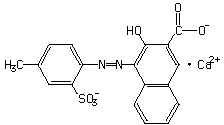

With regard to repeat dose toxicity, males that received 300 mg/kg or more showed significantly decreased serum calcium and phosphorus levels. The 1000 mg/kg males further showed significantly decreased potassium and total cholesterol levels, and increased chloride and GOT levels. The relative kidney weights in the 1000 mg/kg males significantly increased, and the thymus weights in the 100 and 1000 mg/kg females significantly decreased. Histopathological lesions suggesting effects of D&C Red No.7 included an increased incidence of renal tubule regeneration in males that received 300 mg/kg or more, and the increased incidence of renal tubule regeneration and necrotic or foamy tubular epithelial cells in females that received 100 mg/kg or more. These lesions increased in severity and incidence in a dose-dependent manner. NOELs for repeat dose toxicity are considered to be 100 mg/kg/day for males and less than 100 mg/kg/day for females. In terms of reproductive and developmental toxicity, no treatment-related adverse effects were noted. The NOEL for reproductive/developmental toxicity is considered to be 1000 mg/kg/day.
D&C Red No.7 was not mutagenic in Salmonella typhimurium TA100, TA98, TA1535, TA1537 and Escherichia coli WP2 uvrA. Neither structural nor numerical chromosomal aberrations were induced in CHL/IU cells up to the concentration going 50% cell growth inhibition or the limit concentration of 5 mg/ml, in the absence or presence of an exogenous metabolic activation system.
| Purity | : | 98 % |
| Test species/strain | : | Rat/Crj:CD (Sprague-Dawley) |
| Test method | : | OECD Combined Repeat Dose and Reproductive/Developmental Toxicity Screening Test |
| Route | : | Oral (Gavage) |
| Doses | : | 100, 300, 1000 mg/kg/day |
| Number of animals | : | Males, 13; Females, 13/group |
| Vehicle | : | 5% Gum Arabic solution |
| Administration period | : | Males, 42 days
Females, from 14 days prior to mating to Day 3 of lactation |
| Terminal kill | : | Males, Day 43 Females, Day 4 of lactation |
| GLP | : | Yes |
Test results:
NOELs for repeat dose toxicity are considered to be 100 mg/kg/day for males and less than 100 mg/kg/day for females.
| Purity | : | 98% |
| Test species/strains | : | S.typhimurium TA100, TA1535, TA98, TA1537, E. coli WP2 uvrA |
| Test method | : | Guideline for Screening Mutagenicity Testing of Chemicals (Japan) |
| Procedures | : | Plate incorporation method (including azo dye method) |
| Solvent | : | DMSO |
| Positive controls | : | -S9, AF-2 (TA100, WP2, TA98), sodium azide (TA1535) and 9-aminoacridine (TA1537) +S9, 2-aminoanthracene (all strains), trypane blue (TA100, TA98, azo reduction method) |
| Dosage | : | 0, 312.5, 625, 1250, 2500, 5000μg/plate |
| S-9 | : | Rat liver, induced with phenobarbital and 5,6-benzoflavone, Syrian Hamster liver, not induced(azo reduction method) |
| Plates/test | : | 3 |
| Number of replicates | : | 2 |
| GLP | : | Yes |
| + | ? | - | |
| with metabolic activation | [ ] | [ ] | [*] |
| without metabolic activation | [ ] | [ ] | [*] |
| with metabolic activation | [ ] | [ ] | [*] |
| without metabolic activation | [ ] | [ ] | [*] |
| Purity | : | About 98% |
| Type of cell used | : | Chinese hamster CHL/IU cells |
| Test method | : | Guidelines for Screening Mutagenicity Testing of Chemicals(Japan) |
| Solvent | : | 0.5% Carboxymethyl cellulose sodium |
| Positive controls | : | -S9, Mitomycin C +S9, Cyclophosphamide |
| Doses | : | -S9 (continuous treatment): 0, 0.09, 0.19, 0.37 mg/ml -S9 (short-term treatment): 0, 1.3, 2.5, 5.0 mg/ml +S9 (short-term treatment): 0, 1.3, 2.5, 5.0 mg/ml |
| S-9 | : | Rat liver, induced with phenobarbital and 5,6-benzoflavone |
| Plates/test | : | 2 |
| GLP | : | Yes |
| clastogenicity | polyploidy | |||||
| + | ? | - | + | ? | - | |
| without metabolic activation: | [ ] | [ ] | [*] | [ ] | [ ] | [*] |
| with metabolic activation: | [ ] | [ ] | [*] | [ ] | [ ] | [*] |
| 1) | The tests were performed by the Hatano Research Institute, Food and Drug Safety Center, 729-5 Ochiai, Hadano-shi, Kanagawa 257, Japan. Tel +81-463-82-4751 Fax +81-463-82-9627 |